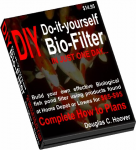DouglasHoover
Douglas Hoover
Are Pond Filters Really Necessary, If So Why?
In nature, ponds normally have a source of incoming fresh water and an outlet which provides a natural clean environment, unlike a man-made pond structure, which can become stagnant.
Why is there so much controversy about pond filtration? The simple answer: Because there are scores of variables and circumstances. Here are a few:
Size and volume of pond, number and size of pond critters, size of pump (volume of water circulated) shape and configuration of pond, type and number of plants, sump pump or centrifugal pump, skimmer, venturi valve, bottom anti-vortex drains, location of drain in relationship to waterfall, bog filter, bio-filter (back-flushable pressurized bead filter or "sludge box type"). Then there are decisions such as whether to put rocks and gravel on the bottom for hiding the liner and collecting decaying fish waste and rotting debris vs. using smooth concrete sealed withThoroseal to prevent leaking and leaching; also for easy cleaning without emptying the pond. Finally, there' deciding whether to use chemicals to control algae or rock salt, depending on the number of times per hour the pond volume of water passes through the filter...
There are many more, but I type with two fingers and I have carpal tunnel from handling millions of pounds of rocks over the last 30 years so I'm stopping here. You got the idea.
A million situations and circumstances creates 5 million opinions and attitudes.
This first paragraph could easily generate hundreds of comments, suggestions, theories, questions, fears and frustrations. Did I mention articles?
My purpose for this post is to help out you DIYourselfers solve your "little pond problems related to dirty, stinky, water.
I am retired and one of my incomes is from selling DIY plans for an incredible bio-filter for ponds up to 1000 gallons that can be built with items purchased from Home Depot or Lowes for just $75 to $95.
I'm making it available FREE to all members of Garden Pond Forum- I only ask that you not reproduce, broadcast, publish, post or share outside the forum, it is trademarked and copyrighted material. PLEASE- this is a portion of our retirement income.
Download from the Amazon Cloud secure server: DIY Bio-Filter Plans Shalom, Douglas Happy koi, peace and joy

In nature, ponds normally have a source of incoming fresh water and an outlet which provides a natural clean environment, unlike a man-made pond structure, which can become stagnant.
Why is there so much controversy about pond filtration? The simple answer: Because there are scores of variables and circumstances. Here are a few:
Size and volume of pond, number and size of pond critters, size of pump (volume of water circulated) shape and configuration of pond, type and number of plants, sump pump or centrifugal pump, skimmer, venturi valve, bottom anti-vortex drains, location of drain in relationship to waterfall, bog filter, bio-filter (back-flushable pressurized bead filter or "sludge box type"). Then there are decisions such as whether to put rocks and gravel on the bottom for hiding the liner and collecting decaying fish waste and rotting debris vs. using smooth concrete sealed withThoroseal to prevent leaking and leaching; also for easy cleaning without emptying the pond. Finally, there' deciding whether to use chemicals to control algae or rock salt, depending on the number of times per hour the pond volume of water passes through the filter...
There are many more, but I type with two fingers and I have carpal tunnel from handling millions of pounds of rocks over the last 30 years so I'm stopping here. You got the idea.
A million situations and circumstances creates 5 million opinions and attitudes.
This first paragraph could easily generate hundreds of comments, suggestions, theories, questions, fears and frustrations. Did I mention articles?
My purpose for this post is to help out you DIYourselfers solve your "little pond problems related to dirty, stinky, water.
I am retired and one of my incomes is from selling DIY plans for an incredible bio-filter for ponds up to 1000 gallons that can be built with items purchased from Home Depot or Lowes for just $75 to $95.
I'm making it available FREE to all members of Garden Pond Forum- I only ask that you not reproduce, broadcast, publish, post or share outside the forum, it is trademarked and copyrighted material. PLEASE- this is a portion of our retirement income.
Download from the Amazon Cloud secure server: DIY Bio-Filter Plans Shalom, Douglas Happy koi, peace and joy

